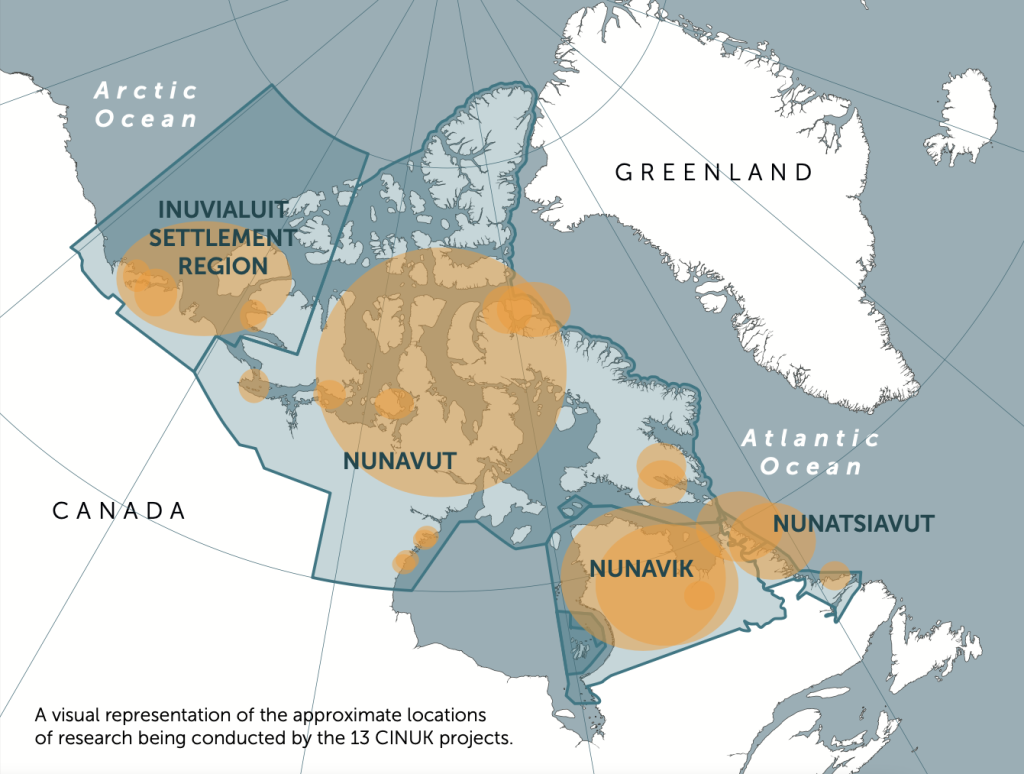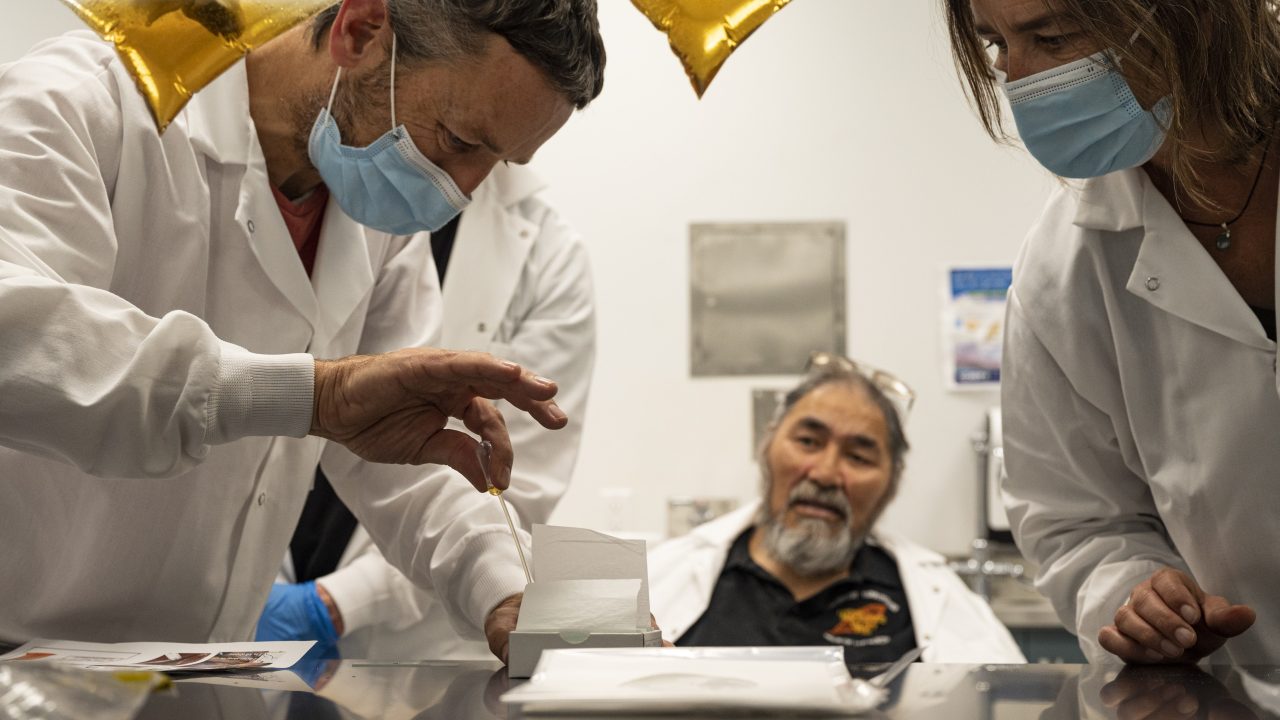Science
The Canada-Inuit Nunangat-United Kingdom Arctic Research Programme is guided by the National Inuit Strategy on Research and seeks to fund projects that feature strong Inuit involvement and are meaningful for Inuit Nunangat communities.
The current and future economic, social, cultural, environmental and health implications of environmental changes for Inuit communities are critical. Inuit disproportionately experience a range of challenges that negatively impact social determinants of health including food security, housing, and mental wellness. Many of these challenges will be exacerbated by rapid changes to the environment.
Projects funded under the CINUK Programme will include effective representation from multiple disciplines of research, including environmental, social, cultural, health, design and engineering. It is expected that the majority of research conducted by projects will take place within Inuit Nunangat. Inuit Nunangat is the Inuit homeland in Canada, encompassing the land claims regions of Nunavut, Nunavik in Northern Quebec, Nunatsiavut in Northern Labrador and the Inuvialuit Settlement Region of the Northwest Territories. It is inclusive of land, water and ice, and describes an area encompassing 35 percent of Canada’s landmass and more than 50 percent of its coastline. If any research is conducted outside of this area, it must demonstrate direct relevance to Inuit Nunangat.
A condition of the funding was for all research teams to consist of a Principal Investigator from the United Kingdom, as well as a Principal Investigator from Canada. It was encouraged that the Canadian Principal Investigator be an Inuk, or a representative from an Inuit Land Claims Organization or their designate or an Inuit Nunangat community. If the Canadian Principal Investigator is not an Inuk, or a representative from an Inuit Land Claims Organization or their designate or an Inuit Nunangat community, an Inuit partner must be a funded Co-investigator in the Research Team and involved from the outset in the co-development of the research proposal.
Each project was asked to address one of two themes:
Theme 1 - Arctic Ecosystems and their Impact on Inuit Communities
This theme must explore research related to understanding dynamic Arctic ecosystems in the context of rapid change and the impact of these changes on Inuit health and well-being. This includes terrestrial and freshwater ecosystems and cryosphere (sea, freshwater or glacial ice, snow, permafrost) research at local, regional and pan-Arctic scales for better models and predictions; the impacts of changing marine and terrestrial environments on local ecosystems and the vitality and well-being of Inuit Nunangat communities and Inuit. Examples of research conducted under this theme could include, but are not limited to:
- collecting baseline information on terrestrial, freshwater and marine ecosystems, including abiotic elements such as the cryosphere;
- monitoring and integrated modelling of terrestrial, freshwater and marine ecosystem changes where baselines have been established, and the consequences of the potential impacts for Inuit communities;
- identifying emerging risks and opportunities from environmental change and the potential impacts to Inuit and Inuit communities to develop timely and effective responses;
- changing ecosystems and the impact on the Arctic’s natural and cultural heritage and challenges and opportunities for conservation of this unique environment;
- changing diversity and accessibility of marine and terrestrial species populations and the challenges and opportunities this presents for food security and quality, and economic diversification;
- climate change influences on Inuit cultural and harvesting activities to improve understanding of associated health outcomes, and allow evidence-based climate adaptation policy-making;
- understanding and projecting climate change induced needs and gaps in the food systems Inuit depend on, including Inuit and market food security;
- knowledge of diseases in northern wildlife, including impacts on country foods and food security;
- effects of pollution and human activities on the local environment (e.g. air quality, water quality, country foods, etc.) and on community and Inuit health and well-being;
- understanding implications of environmental change on national and international laws and security;
- influences of climate change on the social determinants of Inuit health;
- identifying gaps in legislation and policy that contribute to systemic challenges in the areas of health and wellness in the region, and how these might be exacerbated by environmental change;
- issues of mobility for Inuit Nunangat communities, including the drivers for increased or decreased movement of people in the Arctic through changing climate and ecosystems, and the interactions and links with other factors such as forced migration/displacement, local heritage and cultural values, and political and economic drivers.
The CINUK projects looking to address Theme 1 are:
Beavers and Socio-ecological Resilience in Inuit Nunangat
Carving out Climate Testimony: Inuit Youth, Wellness & Environmental Stewardship
Inuit Qaujisarnirmut Pilirijjutit on Arctic Shipping Risks in Inuit Nunangat
Inuksiutit: Food Sovereignty in Nunavut and the co-production of country food knowledge
Sustainable and innovative community-based wildlife health monitoring in Nunavik
Theme 2 – Mitigations and Adaptations for Resilience
This theme must explore research related to innovative, practical and ethical mitigation and adaptation tools and technological solutions derived from understanding the impacts of environmental change on housing, health, food and water. Profound infrastructure gaps exist between Inuit Nunangat and the rest of Canada, and existing infrastructure in Inuit Nunangat is increasingly vulnerable to climate change related issues. Examples of research conducted under this theme could include, but is not limited to:
- technologies for response to changing ground conditions’ effects on community infrastructure, such as permafrost thaw and coastal erosion;
- adaptations for seasonal road systems due to fluctuating environmental conditions and the impact on community access to country foods, health infrastructure and supplies;
- the associated impacts and opportunities of marine transportation upon housing stock, food security and safety, both environmental and personal;
- innovative food, water and waste systems in response to changing environmental conditions for remote communities;
- house-scale renewable energy systems and storage;
- new technologies supporting energy efficiency retrofits in social housing;
- technical innovations, including telehealth services, to support community and Inuit physical and mental health and well-being services, as related to the impacts of climate change;
- resilient technologies for healthy, innovative, adaptive and culturally appropriate housing that address the effects of household crowding on housing performance, as related to the impacts of climate change;
- implications of environmental change on current and future availability and access to clean drinking water in Inuit communities;
- technologies for sustainable development, supporting community priorities;
- technologies that enable interjurisdictional learning and education on sustainable energy options.
The CINUK projects looking to address Theme 2 are:
Plastics and heavy metals in Nunatsiavut food ways and environments
Renewable Energy Microgrid Integration for Remote, Off-grid Cabins in Nunavut
All projects must also address at least two of the three cross-cutting issues below:
- Economics of Arctic change: for example, from local level (subsistence economies, local livelihoods and trading relationships) to new industries, including circular economies, development of new fishing grounds and new logistical hubs, international trade, including global legislation and governance, and tariffs of shipping routes, tourism, and the socio-economic impact of climate change.
- Resilience and sustainability: for example, of communities, infrastructure and industry, and the environment to the changing Arctic; understanding the key determinants and solutions (social, cultural, ethical, economic, geographical, political, infrastructure-related) of Inuit community resilience to rapid Arctic climate change and/or increases in risk of shocks.
- Inuit community health and well-being: for example, the interrelated and interdependent nature of community health and well-being and changes to the natural environment; creating Inuit-specific, culturally relevant, and gender specific health and well-being indicators that incorporate climate vulnerabilities, and monitoring them to document climate change influences on Inuit health.

